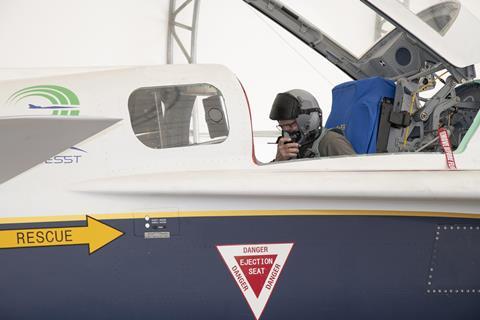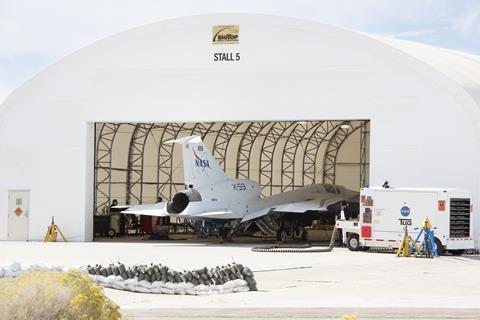The NASA team developing the X-59 supersonic demonstrator jet have fired up the aircraft’s GE Aviation F414-GE-100 powerplant for the first time, having started engine-run tests on 30 October.
The agency, which is developing the jet with industry partner Lockheed Martin, disclosed the milestone on 6 November, saying it now anticipates X-59 will get airborne for the first time in early 2025.

“These engine-run tests… allow the X-59 team to verify the aircraft’s systems are working together while powered by its own engine,” says NASA in a programme update. “The engine-run tests set the stage for the next phase of the experimental aircraft’s progress toward flight.”
The long-delayed X-59 Quiet Supersonic Technology (Quesst) demonstrator is central to NASA’s Low-Boom Flight Demonstration Mission, through which the agency is working to perfect and test designs intended to soften a supersonic aircraft’s sonic boom. NASA has said the work could open the possibility for aircraft to be permitted to fly at supersonic speeds over land. Federal Aviation Administration rules currently prohibit overland supersonic flight.

“In this first phase, the engine rotated at a relatively low speed without ignition to check for leaks and ensure all systems are communicating properly,” NASA says of the engine tests. “The team then fuelled the aircraft and began testing the engine at low power, with the goal of verifying that it and other aircraft systems operate without anomalies or leaks while on engine power.”
NASA says it was finally able to start engine tests after overcoming several “challenges to address technical issues”, though it does not provide details. ”Because of the challenges involved with reaching this critical phase of testing, the X-59’s first flight is now expected in early 2025… The X-59 team will have a more-specific first-flight date as these tests are successfully completed.”
NASA initially hoped X-59 would compete its first flight in autumn 2021. It later pushed that target to 2023, but in August 2023 revealed having discovered a flight-control problem during ground tests at Lockheed’s Skunk Works facility in Palmdale, California.
That issue arose during “structural-coupling” tests, which involved evaluation of “aero-servo elasticity”, NASA chief X-59 engineer Jay Brandon told FlightGlobal at the time. “It did a command that we didn’t expect.”
Aero-servo elasticity refers to the complex interaction between flexible aircraft structures, aerodynamic forces and advanced flight-control systems. In response to the problem, NASA last year moved X-59 back into a tent-like enclosure called a “run stall” for evaluations. At the time, NASA said it still hoped the aircraft would fly before the end of 2023. It did not.


























